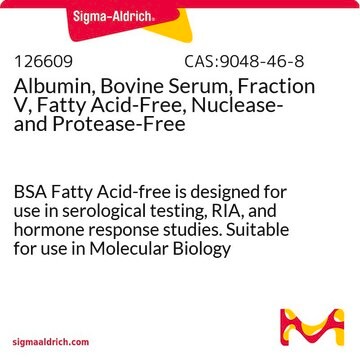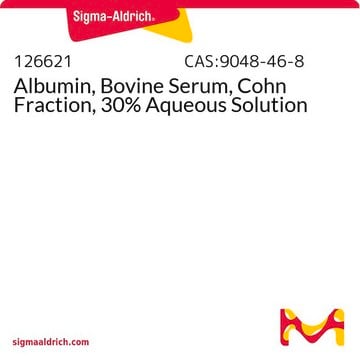126575
Albumin, Bovine Serum, Fraction V, Fatty Acid-Free
Synonyme(s) :
Albumin, Bovine Serum, Fraction V, Fatty Acid-Free
About This Item
Produits recommandés
Pureté
≥95% (cellulose acetate electrophoresis)
Forme
powder
Fabricant/nom de marque
Calbiochem®
Conditions de stockage
OK to freeze
Impuretés
≤0.02% fatty acids
≤3% ash
≤5% moisture
Couleur
white to light yellow
light yellow to light brown
Conditions d'expédition
ambient
Température de stockage
2-8°C
Description générale
Application
- as a component of: blocking buffer immunoelectron microscopy (IEM) for various cells
- mitochondrial isolation buffer (MIB) and mitochondria assay solution (MAS) to trap free fatty acids released during adipose tissue homogenization
- blocking buffer for wholemount staining of the esophageal epithelium (EE) in immunofluorescence
Actions biochimiques/physiologiques
Avertissement
Notes préparatoires
Reconstitution
Informations légales
Code de la classe de stockage
11 - Combustible Solids
Classe de danger pour l'eau (WGK)
WGK 3
Point d'éclair (°F)
Not applicable
Point d'éclair (°C)
Not applicable
Certificats d'analyse (COA)
Recherchez un Certificats d'analyse (COA) en saisissant le numéro de lot du produit. Les numéros de lot figurent sur l'étiquette du produit après les mots "Lot" ou "Batch".
Déjà en possession de ce produit ?
Retrouvez la documentation relative aux produits que vous avez récemment achetés dans la Bibliothèque de documents.
Les clients ont également consulté
Articles
Learn about the impact of filtration on hematopoietic cell culture media containing vital T cell factors and other media components.
16HBE14o- human bronchial epithelial cells used to model respiratory epithelium for the research of cystic fibrosis, viral pulmonary pathology (SARS-CoV), asthma, COPD, effects of smoking and air pollution. See over 5k publications.
Notre équipe de scientifiques dispose d'une expérience dans tous les secteurs de la recherche, notamment en sciences de la vie, science des matériaux, synthèse chimique, chromatographie, analyse et dans de nombreux autres domaines..
Contacter notre Service technique










